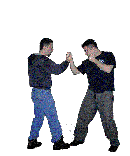Absolute JKD And MKG Arts | home
back to Jun Fan JKD
Trapping
Trapping Concepts
When combatants come together, frequently there will be an obstruction as one of the parties involved raises an arm to block the path of a strike. When an obstruction is met trapping techniques can be used to; 1 limit the opponents offense, 2 create space for a hit, 3 change the attribute set to favor a trained fighter, 4 use an opponents energy against them.
Training in trapping range gives you the opportunity to; examine a structure of offense and defense in which one can build on, promote muscle memory for in fighting, provide proper mechanics for a strong power base, increase speed and economy of motion in short range tactics, allow techniques to flow in a practical manor predicated on the responses of the opponent.
Trapping drills in Jun Fan Jeet Kune Do were originally designed by the late Bruce Lee. Lee used his experience in Wing Chung Kung Fu to give him valuable insights into trapping range combat. These skill sets have been further developed by Dan Inosanto, Bruce Lee's most senior instructor to help further promote skill and attribute development.
At the MKG phase 1 students are taught standard trapping sequences based off an obstruction. This obstruction or cohesion is either simply started from or forced by attacking the high line or low line with finger pokes, jabs or similar lead arm attacks.
The responses to the obstruction determines what openings are to be exploited and pursued.
(answer was weak)
For example: When in the mix and cohesion is met, or resistance is felt
Obstruction
 |
Pak Sau
 |
Lap Sau
 |
Gum Sau
 |
For varying energies these are a few of the variable drills
(answer was as strong as attack)
(resists or locks up)
(resists or locks up)
These entrees are meant to bridge the gap and allow the use of heavy tools like elbows knees and head butts; finishing combinations like cross, hook, croos(orHCH,CUpctH, etc.); or grappling locks, throws and sweeps.
For example
Obstruction
 |
Pak Sau
 |
Lap Sau
 |
Gum Sau
 |
Elbow Bicep
 |
Arm Drag/Throw
 |
Wrist Lock
 |
Arm Lock/ Knee Drop
 |
This is one of our favorite finishes. The defender is left in an upright position able to negotiate and if necessary; flee, severely damage the assailant, and/or engage another assailant.
Once we are familiar with the basic movements and line of attacks we can "play" with the drills and structure them for varying responses. For example if the Front hand locks up when met, instead of Lop or jao-ing out to the outside, maybe we jao to the inside line, which if picked up, then we lop and gum sao. Remember to account for the free hand until both are accounted for.
Most of the hits in the trapping sequences are not meant to end the fight but set up the target for good tranquilizer shots like elbows, head buts, or knees; or may flow into locks, throws and sweeps.